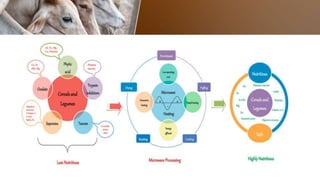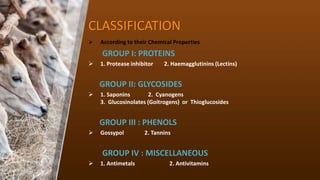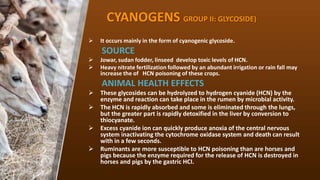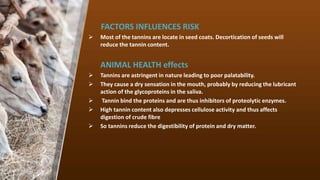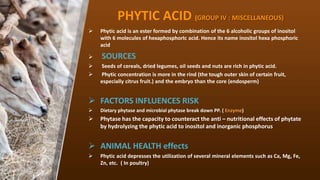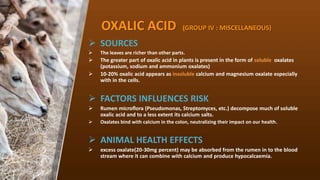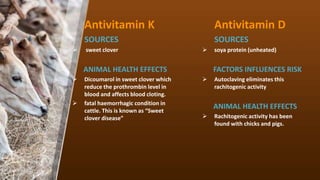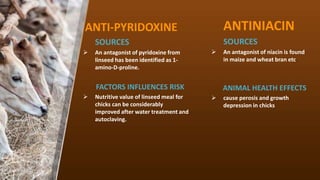anti nutrition factor.pptx
- 1. ANTI-NUTRITIONAL FACTORS substances present in the diet which by themselves or their metabolic products arising in the system interfere with the feed utilization ,reduce production or affects the health of the animal.
- 3. CLASSIFICATION ? According to their Chemical Properties GROUP I: PROTEINS ? 1. Protease inhibitor 2. Haemagglutinins (Lectins) GROUP II: GLYCOSIDES ? 1. Saponins 2. Cyanogens 3. Glucosinolates (Goitrogens) or Thioglucosides GROUP III : PHENOLS ? Gossypol 2. Tannins GROUP IV : MISCELLANEOUS ? 1. Antimetals 2. Antivitamins
- 4. PROTEASE INHIBITOR (Group I: Proteins) ? Substances that have the ability to inhibit the proteolytic activity of certain digestive enzymes. ? Protease inhibitors are two types: 1. kunitz inhibitor (inhibits only trypsin) 2. Bowman-birk inhibitor (inhibits trypsin and Chymotrypsin SOURCES ? legume seeds and soya bean ANIMAL HEALTH EFFECTS ? Young chicken fed raw soybean developed hypertrophy of the pancreas. ? FACTORS INFLUENCES RISK ? 1.Temperature 2.Duration of heating 3.Particle size 4.Moisture level.
- 5. Haemagglutinins (Lections) (Group 1: proteins) SOURCE ? Soybean, Castorbean (ricin) and other legume seeds contain haemagglutinins. ANIMAL HEALTH EFFECTS ? These toxic substances are able to combine with the glycoprotein components of red blood cells (RBC) causing agglutination of the cells. ? Ricin is extremely toxic. It causes severe inflammatory changes in the intestines, kidney and thyroid gland. FACTORS INFLUENCES RISK ? Lectins are resistant to destruction by dry heat & are destroyed by steam.
- 6. SAPONIN (GROUP II: GLYCOSIDE) SOURCES ? These are glycosides characterized by bitter taste. ? The important common forages which cause saponin poisoning of livestock are Lucerne, soybean etc. ? ANIMAL HEALTH EFFECTS ? Excess feeding of green lucerne or legume forages saponin slower the surface tension of ruminal contents leading to accumulation of gas, condition is known as ˇ°bloatˇ± This is also know as tympany/tympnitis. ? FACTORS INFLUENCES RISK ? Turpentine and paraffin oil are helpful in reducing bloat.
- 7. CYANOGENS GROUP II: GLYCOSIDE) ? It occurs mainly in the form of cyanogenic glycoside. SOURCE ? Jowar, sudan fodder, linseed develop toxic levels of HCN. ? Heavy nitrate fertilization followed by an abundant irrigation or rain fall may increase the of HCN poisoning of these crops. ANIMAL HEALTH EFFECTS ? These glycosides can be hydrolyzed to hydrogen cyanide (HCN) by the enzyme and reaction can take place in the rumen by microbial activity. ? The HCN is rapidly absorbed and some is eliminated through the lungs, but the greater part is rapidly detoxified in the liver by conversion to thiocyanate. ? Excess cyanide ion can quickly produce anoxia of the central nervous system inactivating the cytochrome oxidase system and death can result with in a few seconds. ? Ruminants are more susceptible to HCN poisoning than are horses and pigs because the enzyme required for the release of HCN is destroyed in horses and pigs by the gastric HCI.
- 8. GLUCOSINOLATES (GROUP II: GLYCOSIDE) ? These glucosinolates are responsible for the pungent flavors SOURCES ? Most plant of cruciferae family (Cabbage, turnips rutabaga, rapeseed and mustard green) contain these substances. ANIMAL HEALTH EFFECTS ? Their main biological effect is to depress the synthesis of the thyroid hormone (T4 and T3) thus producing goiter. ? Goiter is not caused by the glucosinolates , but by their products of hydrolysis. ? enzyme myrosinase , which is capable of hydrolyzing them to thiocyanates and isothiocyanates or nitriles (Isothiocyanates produce goitrin and thiocyanates lead to increased hypothyroidism). ? Growth depression and enlargement of liver and kidneys are also observed in chicks and pigs. FACTORS INFLUENCES RISK ? WATER TREATMENT, HEAT TREATMENT AND Copper sulphate treatment Solid state fermentation
- 9. GOSSYPOL (COTTON SEED) GROUP III: PHENOLS SOURCES ? In genus Gossypium gossypol is present in pigment glands of leaves, stems roots and seeds FACTORS INFLUENCING RISK ? Gossypol form complex with metals like iron and the toxic effect can be over come by supplementing iron as ferrous sulphate (1:1). ? Commercial production of cotton seed meal heat treatment decreases the content of free gossypol
- 10. ANIMAL HEALTH EFFECTS ? It is highly toxic to mono gastric animals. Pigs and rabbits are more sensitive than poultry. ? Horses are resistant. ? Ruminants are more resistant due to the formation of stable complexes with soluble protein in rumen which are resistant to enzymatic break down. ? IN LAYING HENS ? 0.15% free gossypol reduced egg production. Egg yolk will have an olive green colour. ? Further higher levels cause yellow brown pigments in liver and spleen due to destructive effect on red blood cells. ? IN PIGS ? A dietary level 0.01% reduced growth rate while 0.015% showed toxic symptoms. ? New varieties of cotton seed less than 0.01% total gossypol (0.002% in the free form) are available.
- 11. TANIN (GROUP III : PHENOLS) ? Tannins are of two types. A. HYDROLYSABLE TANNINS ? These can be readily hydrolysed by water, acids, bases or enzymes and yield gallotannins ? and ellagitannins. B. CONDENSED TANNINS ? These are Flavonoids polymers of flavonol. ? Both hydrolysable and condensed tannins are widely distributed in nature SOURCES ? Sorghum , Mango seed cake, Mustard oil cake and Lucerne meal ? Sorghum contains high levels of condensed tannins.
- 12. FACTORS INFLUENCES RISK ? Most of the tannins are locate in seed coats. Decortication of seeds will reduce the tannin content. ANIMAL HEALTH effects ? Tannins are astringent in nature leading to poor palatability. ? They cause a dry sensation in the mouth, probably by reducing the lubricant action of the glycoproteins in the saliva. ? Tannin bind the proteins and are thus inhibitors of proteolytic enzymes. ? High tannin content also depresses cellulose activity and thus affects digestion of crude fibre ? So tannins reduce the digestibility of protein and dry matter.
- 13. PHYTIC ACID (GROUP IV : MISCELLANEOUS) ? Phytic acid is an ester formed by combination of the 6 alcoholic groups of inositol with 6 molecules of hexaphosphorIc acid. Hence its name inositol hexa phosphoric acid ? SOURCES ? Seeds of cereals, dried legumes, oil seeds and nuts are rich in phytic acid. ? Phytic concentration is more in the rind (the tough outer skin of certain fruit, especially citrus fruit.) and the embryo than the core (endosperm) ? FACTORS INFLUENCES RISK ? Dietary phytase and microbial phytase break down PP. ( Enzyme) ? Phytase has the capacity to counteract the anti ¨C nutritional effects of phytate by hydrolyzing the phytic acid to inositol and inorganic phosphorus ? ANIMAL HEALTH effects ? Phytic acid depresses the utilization of several mineral elements such as Ca, Mg, Fe, Zn, etc. ( In poultry)
- 14. OXALIC ACID (GROUP IV : MISCELLANEOUS) ? SOURCES ? The leaves are richer than other parts. ? The greater part of oxalic acid in plants is present in the form of soluble oxalates (potassium, sodium and ammonium oxalates) ? 10-20% oxalic acid appears as insoluble calcium and magnesium oxalate especially with in the cells. ? FACTORS INFLUENCES RISK ? Rumen microflora (Pseudomonas, Streptomyces, etc.) decompose much of soluble oxalic acid and to a less extent its calcium salts. ? Oxalates bind with calcium in the colon, neutralizing their impact on our health. ? ANIMAL HEALTH EFFECTS ? excess oxalate(20-30mg percent) may be absorbed from the rumen in to the blood stream where it can combine with calcium and produce hypocalcaemia.
- 15. ANTI VITAMINS (GROUP IV : MISCELLANEOUS) Antivitamin A SOURCES ? Raw soybean contains enzyme Lipoxygenase Lipoxygenase FACTORS INFLUENCES RISK ? It can be destroyed by heating 5min with steam at atmospheric pressure. ANIMAL HEALTH EFFECTS ? catalyses oxidation of carotene the precursor of vitamin A Antivitamin E SOURCES ? Diets with raw kidney beans FACTORS INFLUENCES RISK ? Autoclaving destroys the factor ANIMAL HEALTH EFFECTS ? produced muscular dystrophy in chicks and lambs by reducing plasma vitamin E
- 16. Antivitamin K SOURCES ? sweet clover ANIMAL HEALTH EFFECTS ? Dicoumarol in sweet clover which reduce the prothrombin level in blood and affects blood cloting. ? fatal haemorrhagic condition in cattle. This is known as ˇ°Sweet clover diseaseˇ± Antivitamin D SOURCES ? soya protein (unheated) FACTORS INFLUENCES RISK ? Autoclaving eliminates this rachitogenic activity ANIMAL HEALTH EFFECTS ? Rachitogenic activity has been found with chicks and pigs.
- 17. ANTINIACIN SOURCES ? An antagonist of niacin is found in maize and wheat bran etc. ANIMAL HEALTH EFFECTS ? cause perosis and growth depression in chicks ANTI-PYRIDOXINE SOURCES ? An antagonist of pyridoxine from linseed has been identified as 1- amino-D-proline. FACTORS INFLUENCES RISK ? Nutritive value of linseed meal for chicks can be considerably improved after water treatment and autoclaving.

